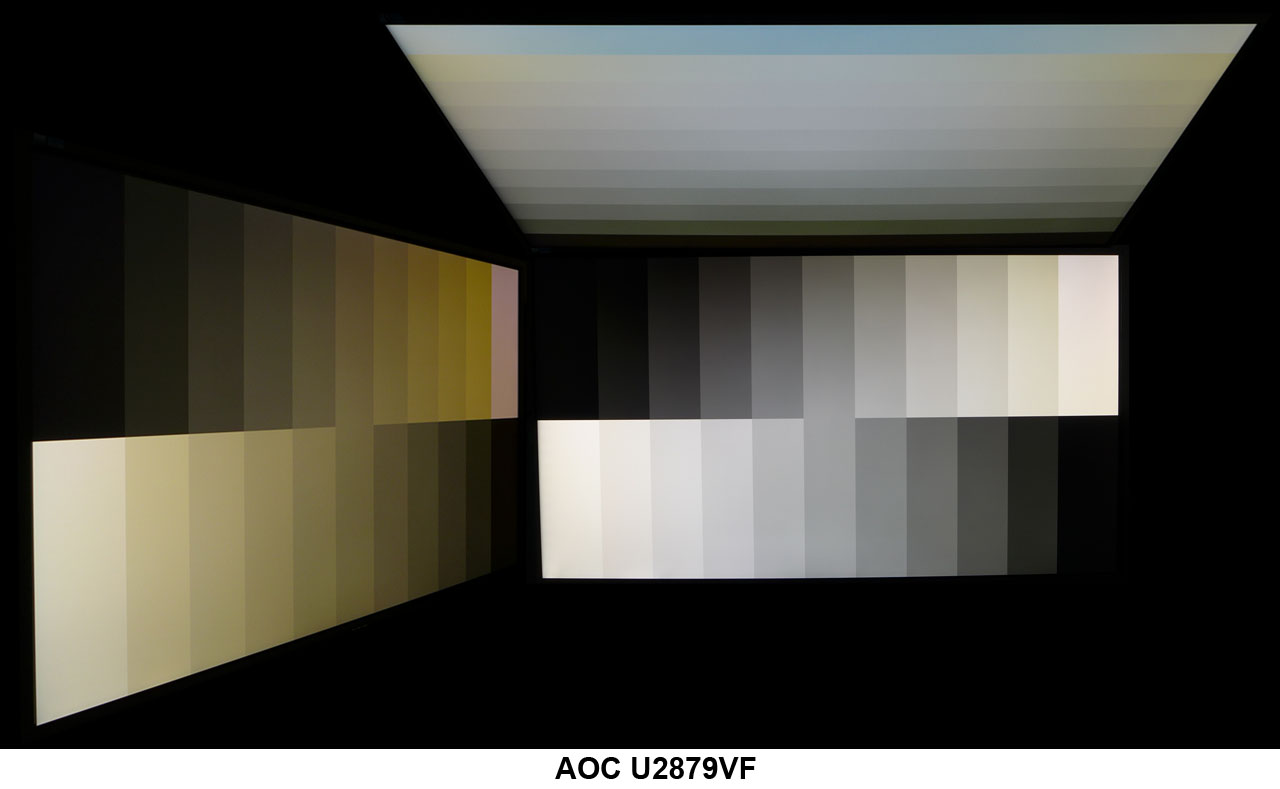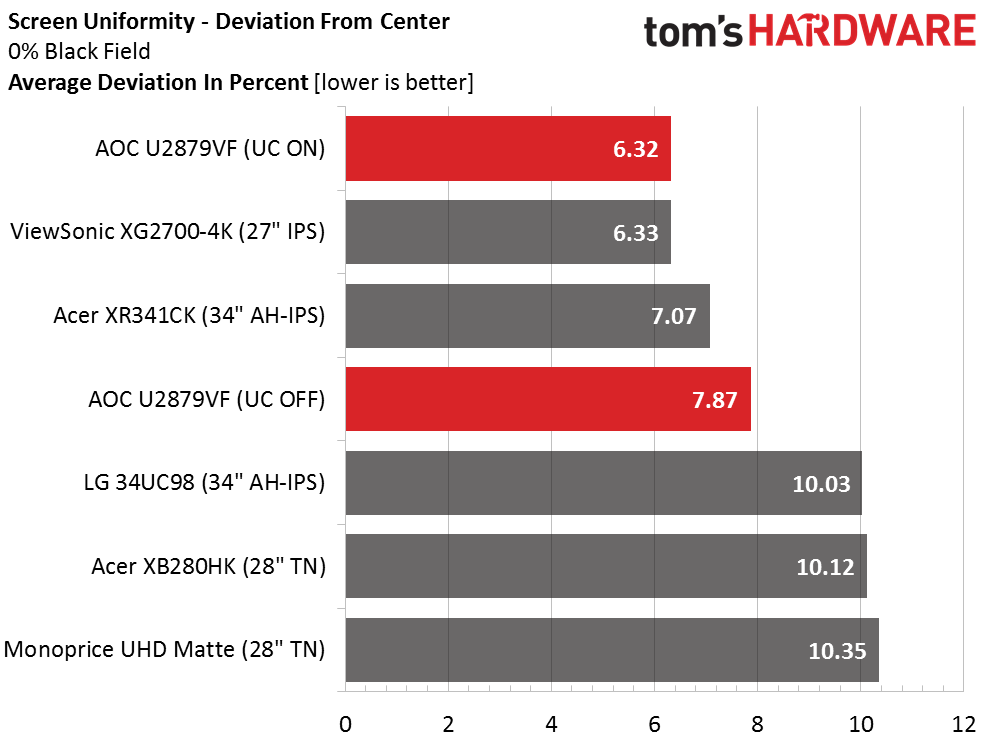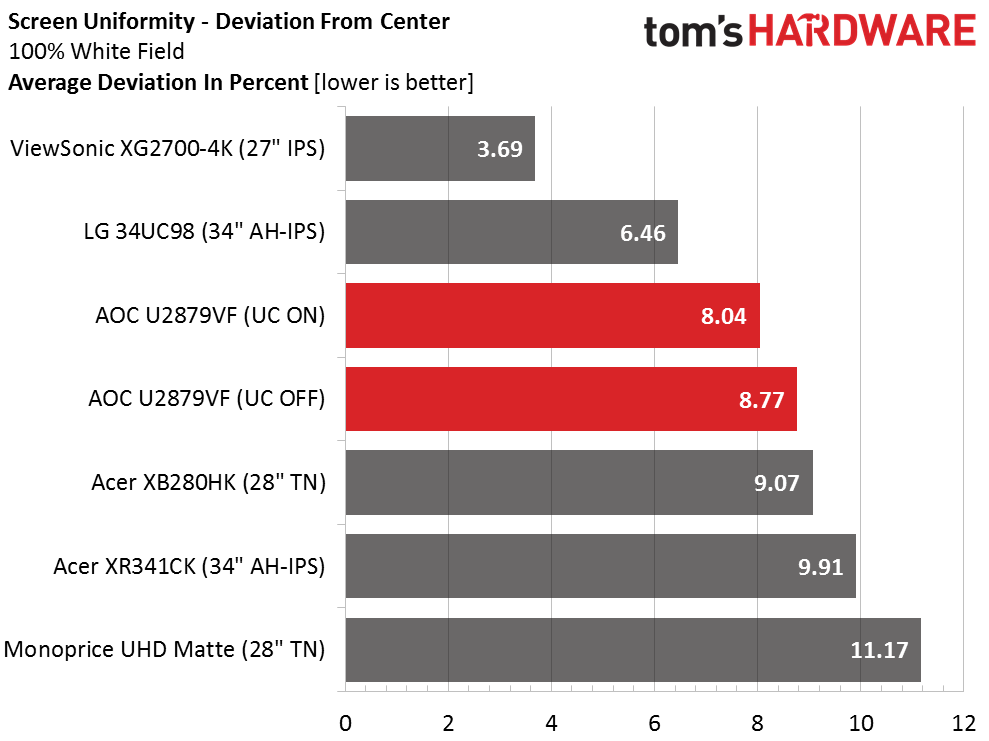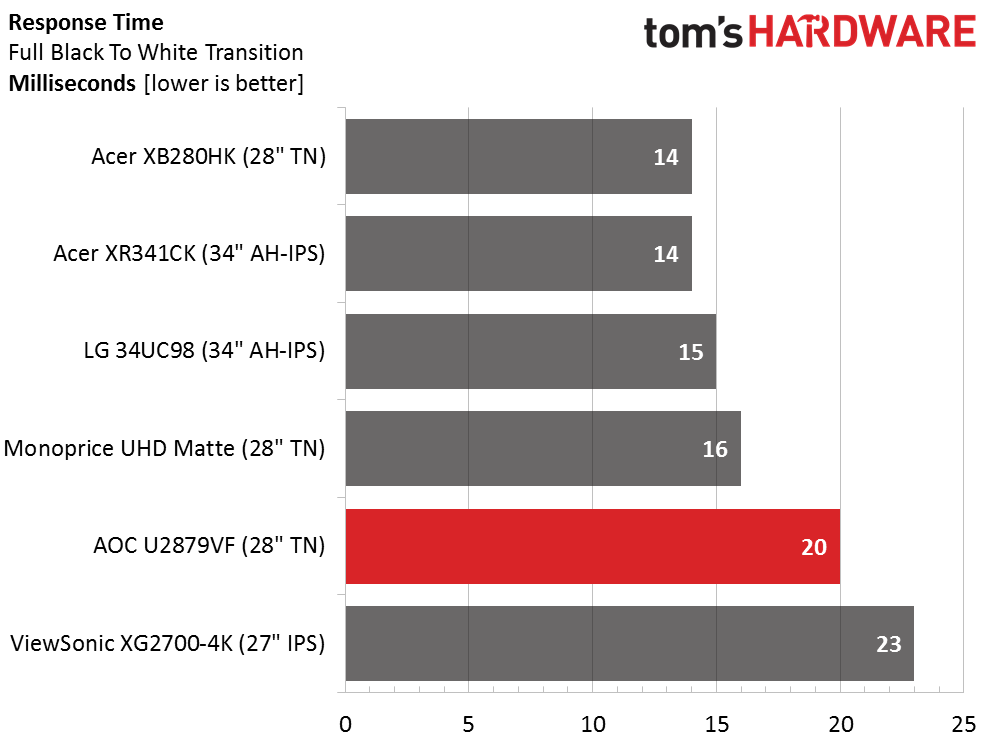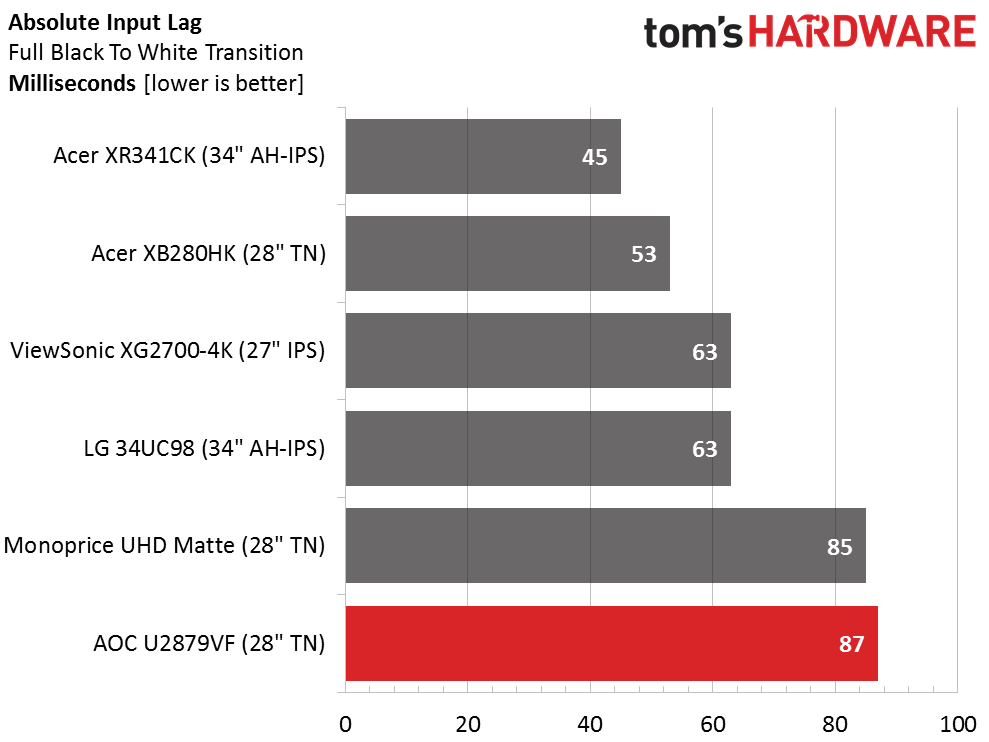AOC U2879VF 28-inch Ultra HD FreeSync Monitor Review
A 28-inch TN screen is the cheapest way to put Ultra HD on the desktop. Today, we're looking at a new example from AOC: the U2879VF. It includes FreeSync for gaming enthusiasts and a factory calibration for the professional user.
Why you can trust Tom's Hardware
Viewing Angles, Uniformity, Response And Lag
To learn how we measure screen uniformity, please click here.
This is a fairly typical result for any TN panel but if you look closely you'll see a little more shadow detail in the side-angle view. Most monitors we photograph can't distinguish the bottom two brightness steps. There is also an obvious color shift to red and green but again, it's not quite as severe as other TN panels we've worked with. From the top, there is significant loss of detail from a gamma shift. In the head-on viewing position however, we'd say it's a little easier to position the U2879VF than other Ultra HD TN screens.
Screen Uniformity: Luminance
We ran our uniformity tests with and without compensation and found only a small measureable, and no visible difference. This is a high-quality panel that doesn't need any help to look good. Our sample had no light-bleed or hotspots whatsoever.
Here's the white field measurement.
AOC hasn't engineered any appreciable compensation into the brighter end of the scale. Not only is there no real change in uniformity, output is almost exactly the same too. While we applaud AOC's attention to detail, we wouldn't call this a defining feature of the U2879VF.
Screen Uniformity: Color
Color uniformity is similarly unaffected. We couldn't see a difference and apparently our i1Pro barely could either. We have absolutely no complaints with our sample. It provides an excellent picture regardless of application.
Pixel Response And Input Lag
Please click here to read up on our pixel response and input lag testing procedures.
Get Tom's Hardware's best news and in-depth reviews, straight to your inbox.
Here's where the gaming monitor designation gets a bit fuzzy. AOC mentions the professional credibility of the U2879VF in its marketing and backs it up with calibration data and great color performance. But the inclusion of FreeSync will naturally appeal to gamers. In our response test however, we recorded performance more on par with a general-use screen. The Acer XB280HK, which uses the same panel, can draw a frame in only 14ms at the same 60Hz. While this may not seem like a huge difference, it does have a perceptible effect on motion blur. The AOC has just a little more. Overdrive will improve motion resolution a little but we would like to see faster response from a gaming display.
Here are the lag results.
Input lag is disappointing at 87ms. While casual players won't regret purchasing the U2879VF, those with fast reflexes may find themselves at a disadvantage. For sheer speed and the best use of a 60Hz refresh rate, the Acer XB280HK is still the top choice for Ultra HD gaming, albeit a more expensive one thanks to G-Sync.
Gaming With FreeSync
After recording less-than-stellar response and lag numbers, we were anxious to try the AOC under real-world conditions. Ultra HD gaming is a challenge after all, especially with our Radeon R9 285-equipped testbed. Its performance is not really sufficient to drive eight-plus mega-pixels with speed but if detail levels are lowered, we can achieve playable framerates. We started with overdrive maxed and detail adjusted to keep us inside the FreeSync operating range of 40-60Hz.
Battlefield 4 is our least-demanding title and can be played comfortably at 50-60fps in high detail mode. We found the overdrive sweet spot to be at the medium setting. Strong causes too much ghosting and weaker options expose obvious motion blur. This is where a higher refresh rate would really be welcome. We saw no ill effects from the U2879VF's panel response but there was a barely perceptible sense of input lag. It didn't affect our ability to play the game but when the mouse was moved rapidly we could see a tiny delay. Highly-skilled gamers will likely want a more responsive screen. Honestly, we're not sure any Ultra HD monitor is quite ready for the rigors of serious competition.
As with any FreeSync display, keeping the fps count above the minimum (in this case 40) is key. Lower numbers mean excessive judder and lag as V-Sync takes over. There won't be any tearing but gameplay takes a serious dive in quality. And the U2879VF doesn't qualify for low-framerate compensation with its narrow operating range.
In the Ultra HD gaming category, this isn't our favorite but it is adequate for casual play. Overdrive works reasonably well and input lag will only be an issue for the more-competent player.
Current page: Viewing Angles, Uniformity, Response And Lag
Prev Page Color Gamut And Performance Next Page Conclusion
Christian Eberle is a Contributing Editor for Tom's Hardware US. He's a veteran reviewer of A/V equipment, specializing in monitors. Christian began his obsession with tech when he built his first PC in 1991, a 286 running DOS 3.0 at a blazing 12MHz. In 2006, he undertook training from the Imaging Science Foundation in video calibration and testing and thus started a passion for precise imaging that persists to this day. He is also a professional musician with a degree from the New England Conservatory as a classical bassoonist which he used to good effect as a performer with the West Point Army Band from 1987 to 2013. He enjoys watching movies and listening to high-end audio in his custom-built home theater and can be seen riding trails near his home on a race-ready ICE VTX recumbent trike. Christian enjoys the endless summer in Florida where he lives with his wife and Chihuahua and plays with orchestras around the state.
-
Urzu1000 I've been using this monitor for month or so now, and I have to say, I'm very pleased with my purchase. I got it on sale though, so it was a bit cheaper.Reply -
gaborbarla Please call me when these monitors are no longer only 60Hz. I still much prefer a 1440p monitor with 144Hz over 4k on 60Hz for gaming.Reply -
Dynomite54 ReplyPlease call me when these monitors are no longer only 60Hz. I still much prefer a 1440p monitor with 144Hz over 4k on 60Hz for gaming.
I can I agree with that for the people with better eye sight its blurry if its 60Hz but not if its 144Hz or 120Hz.
-
sillynilly While I understand that 60 FPS may be the top for high end gaming rigs for this resolution - that is in some games, not all. I agree 2160 at 60Hz is, for me, a step back from 1440 at 120Hz+ since my rig can easily push higher FPS on many games I play regularly.Reply -
masterofevil22 I'm currently rocking 3 1440p monitors in Eyefinity and I love them for Gaming at 7680x1440p. They are 60hz panels, but I can OC'd them to 75hz. It's not easy getting 75fps at that res maxed out tho... 11.2 million pixels is no joke, but the FEEL of them wrapping around you is incredible & it's widely supported (hehe) by most games. I'd highly recommend anyone giving it a try. I've got some footage up on XBnPC if you all care to check it out.Reply -
milk_inc ReplyWhile I understand that 60 FPS may be the top for high end gaming rigs for this resolution - that is in some games, not all. I agree 2160 at 60Hz is, for me, a step back from 1440 at 120Hz+ since my rig can easily push higher FPS on many games I play regularly.
Well right now is not a video card that can be played at 100+fps on 4k with ultra settings, even the 1080 as good it's, not reach those frames on 4k of course and AAA games.
The monitor is for the present 4k at 60hz even the prices it's good for the spec.
The speed of hz and the resolution are two different things, of course you will get higher hz at lower resolution. In a near future it will be 4k with 120hz or 144hz, coz 4k will be standard for 5 years as 1080p and 1440 or qhd will just be a transitition as was 720p.
-
photonboy *Freesync doesn't work well at 40 to 60Hz.Reply
You need 2.5X minimum ratio for asynchronous mode (i.e. 30 Hz to 75Hz) or you have no support below 40Hz.
With the range being so low you are popping in and out of the smoother asynchronous mode any time you go above or below this. If it's setup for VSYNC ON you'll go from smooth gameplay to STUTTERING below 40FPS (or screen tear if setup for VSYNC OFF).
Same goes for above 60FPS (though I think you can force a Global cap but you have to experiment with that and it may have to be a bit below 60FPS).
*If you have a 30Hz to 144Hz it's far better. Not only is it hard to go over 144FPS, but for demanding games (or sudden drops even if good FPS) you CAN stay in asynchronous mode.
The REASON is that AMD has no module like GSYNC does. So if you drop to 29FPS then the drivers tell the GPU to send each frame 2X so the monitor gets 58FPS. You still see it as 29FPS but a SMOOTH 29FPS because you stay in asynchronous mode so the monitor draws each frame as it gets it.
There is a small DELAY in doing this so you can't get by with just 2X the range. So again, for the 40Hz to 60Hz range if you drop to 39FPS it doesn't work.
**IMO they shouldn't even sell Freesync monitors like this. If you don't understand what's going on you're going to have an inconsistent experience with many games being smoother then stutter or tear constantly. -
sillynilly Reply17989601 said:While I understand that 60 FPS may be the top for high end gaming rigs for this resolution - that is in some games, not all. I agree 2160 at 60Hz is, for me, a step back from 1440 at 120Hz+ since my rig can easily push higher FPS on many games I play regularly.
Well right now is not a video card that can be played at 100+fps on 4k with ultra settings, even the 1080 as good it's, not reach those frames on 4k of course and AAA games.
The monitor is for the present 4k at 60hz even the prices it's good for the spec.
The speed of hz and the resolution are two different things, of course you will get higher hz at lower resolution. In a near future it will be 4k with 120hz or 144hz, coz 4k will be standard for 5 years as 1080p and 1440 or qhd will just be a transitition as was 720p.
Umm, ya? That's the underlying point of my entire post! To expand, I am not willing to spend money on a monitor that is "for now" ok, when I find the 1440 experience (on IPS panels) so good. Since I run 27 now, why go a minor increase for a 4K panel that won't look as good while gaming, i.e. low frame rates? And to get even more specific - I am team green so I wouldn't buy an FS monitor in the first place! :lol:
-
Gurg I have an earlier version AOC U2870VQE 28" 4K LED Monitor I bought for roughly the same price.. I really like it. This was an upgrade from another brand 1440 monitor that was returned under warranty for too many dead pixels. This AOC has no bad pixels. Mostly play Total War games with 2x980sli. For reference my everyday overclocked Firestrike Ultra graphics score is around 6650 with max of around 7000. I generally play at high settings rather than ultra because I like to speed battles up 2 or 4 times speed during slower action periods to move them along quicker.Reply
